El Niño To Bring El Termites To Arizona
Rain
Rain, rain glorious rain. The El Niño is upon us this year and boy do we need it. According to the Arizona State climate office, we are in our 22nd year of a long-term drought. Randy Cerveny, a climatologist with Arizona State University, stated on KTAR News, the storms that normally hit Seattle will come down here. “This year, we’re going to become Seattle.” So what does this mean for you and your home, in regards to subterranean termites, this year? Let’s take a look at subterranean termite biology and behavior to help us understand.
Socialites
Subterranean termites are social insects and live in colonies. They share in the duties and resources for colony survival,
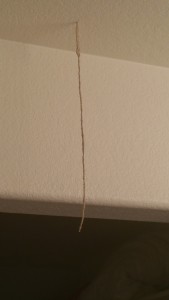
Fig. 1
like foraging for food, taking care of the eggs and young, grooming and feeding the queen. But unlike other social insects, termites do not have a centralized nesting site. They are mobile and go where the conditions are best for colony survival, with plentiful moisture and a food source. (i.e., your home). So that brings us to this year’s El Niño season.
Moisture
Subterranean termites have thin exoskeletons, cannot survive out in the open, and need to return to the soil every 24 to 48 hours to retain their moisture. Speaking of moisture, take a look at termites seeking out moisture on a particularly dry year that I took a few years back. (Fig. 0) They construct shelter tubes for protection and to help retain moisture. It is common to see a termite shelter tube hanging from the ceiling. (Fig. 1) This is because the termites are trying to find a quicker route to return to the soil and replenish their moisture. With the El Niño season bringing torrential down pours, the conditions conducive for termite colony expansion will be greater than in years with less rain.
Look
Most subterranean termite activity will be discovered on the exterior of your home. The termites will construct a shelter tube on the stem wall of your home to access their food, the dead wood and other cellulose materials in your home. (Fig’s. 2 and 3) Subterranean termites only need about 1/64th of an inch to enter your home. That’s about the thickness of a business card. Other entry points can include cracks in the concrete, the expansion joint of the concrete,(Fig. 4) and by following plumbing through the concrete. Subterranean termites can also be discovered popping through and tunneling along your drywall, hanging from the ceiling, and eating away your door trim, baseboards or wainscoting, (fig. 5) just to name a few. It is recommended that you have your home inspected at least annually. Having a monthly or bimonthly pest control service is a good way to have your home inspected more frequently. Technicians are inspecting your home as they treat anyways and could discover termite activity sooner.
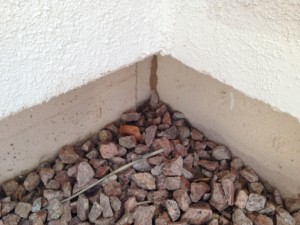
Fig. 2
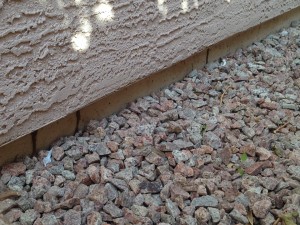
Fig. 3
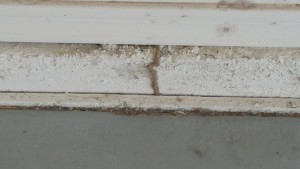
Fig. 4
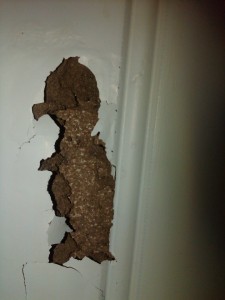
Protection
As most Realtors in Arizona will tell you, “It’s not if, but when you will get termites”. That being said, you can protect your home, your most valuable possession. If termites are not present, you can purchase a warranty program. The cost for warranty program is typically $175-$250 for an average size home. You can also do a preventative treatment. This is less expensive than a traditional treatment. The treatment protects your home by having a barrier in place should termites discover your home. After all, there are 14-16 colonies per acre in Arizona. Cost for a preventive termite treatment, for an average size home is in the $400-$600 range. If termites are present, you should have your home treated to eliminate the subterranean termites and prevent any further damage to your home. The most common termiticide these days are non-repellents (i.e., Termidor HE or Premise). These termiticides will eliminate the colony in 60-90 days verses repelling them further underneath your home or to your neighbors. Every home is different, so the treatment cost can vary. A two story, 4ooo square foot home may be less expensive than a 2000 square foot single story home. It’s all based on linear feet, material used, and warranty duration. Average treatment cost is between $500-$900. It is always best to have a licensed technician measure your home for the most accurate proposal. We of course will do the inspection at no cost to you.
Conclusion
Although this article is not intended to cover every aspect of termite discovery, treatment, or prevention, I hope I was able to educate you on what to look for and ways to protect your home. As always, should you have any questions, feel free to give us a call.


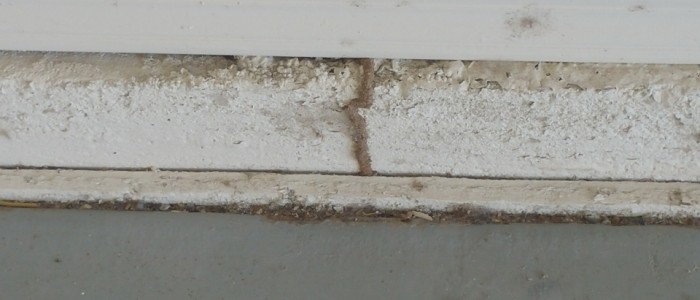
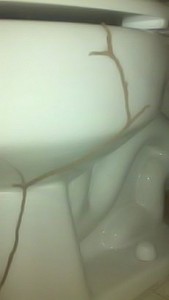
Comments are closed.